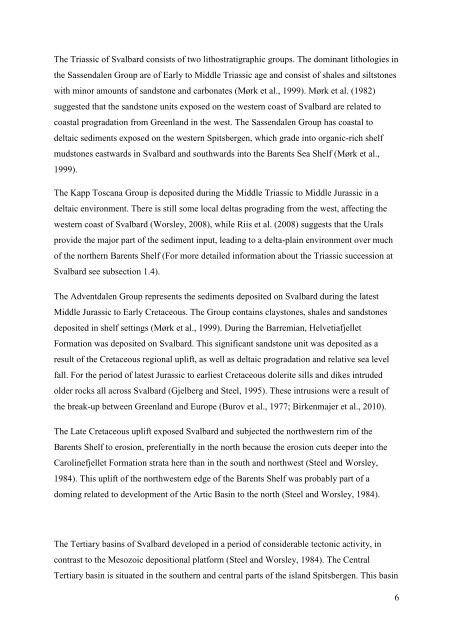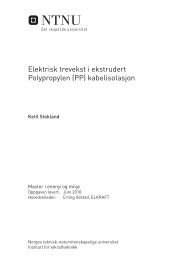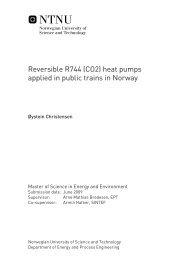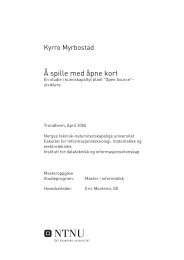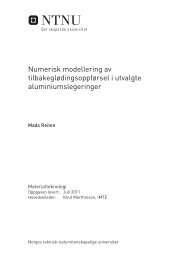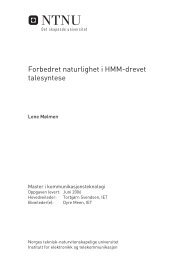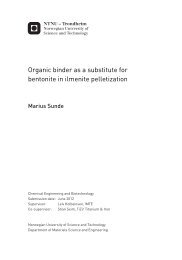Visualize and interpret the geometry, heterogeneity and lateral ...
Visualize and interpret the geometry, heterogeneity and lateral ...
Visualize and interpret the geometry, heterogeneity and lateral ...
You also want an ePaper? Increase the reach of your titles
YUMPU automatically turns print PDFs into web optimized ePapers that Google loves.
The Triassic of Svalbard consists of two lithostratigraphic groups. The dominant lithologies in<strong>the</strong> Sassendalen Group are of Early to Middle Triassic age <strong>and</strong> consist of shales <strong>and</strong> siltstoneswith minor amounts of s<strong>and</strong>stone <strong>and</strong> carbonates (Mørk et al., 1999). Mørk et al. (1982)suggested that <strong>the</strong> s<strong>and</strong>stone units exposed on <strong>the</strong> western coast of Svalbard are related tocoastal progradation from Greenl<strong>and</strong> in <strong>the</strong> west. The Sassendalen Group has coastal todeltaic sediments exposed on <strong>the</strong> western Spitsbergen, which grade into organic-rich shelfmudstones eastwards in Svalbard <strong>and</strong> southwards into <strong>the</strong> Barents Sea Shelf (Mørk et al.,1999).The Kapp Toscana Group is deposited during <strong>the</strong> Middle Triassic to Middle Jurassic in adeltaic environment. There is still some local deltas prograding from <strong>the</strong> west, affecting <strong>the</strong>western coast of Svalbard (Worsley, 2008), while Riis et al. (2008) suggests that <strong>the</strong> Uralsprovide <strong>the</strong> major part of <strong>the</strong> sediment input, leading to a delta-plain environment over muchof <strong>the</strong> nor<strong>the</strong>rn Barents Shelf (For more detailed information about <strong>the</strong> Triassic succession atSvalbard see subsection 1.4).The Adventdalen Group represents <strong>the</strong> sediments deposited on Svalbard during <strong>the</strong> latestMiddle Jurassic to Early Cretaceous. The Group contains claystones, shales <strong>and</strong> s<strong>and</strong>stonesdeposited in shelf settings (Mørk et al., 1999). During <strong>the</strong> Barremian, HelvetiafjelletFormation was deposited on Svalbard. This significant s<strong>and</strong>stone unit was deposited as aresult of <strong>the</strong> Cretaceous regional uplift, as well as deltaic progradation <strong>and</strong> relative sea levelfall. For <strong>the</strong> period of latest Jurassic to earliest Cretaceous dolerite sills <strong>and</strong> dikes intrudedolder rocks all across Svalbard (Gjelberg <strong>and</strong> Steel, 1995). These intrusions were a result of<strong>the</strong> break-up between Greenl<strong>and</strong> <strong>and</strong> Europe (Burov et al., 1977; Birkenmajer et al., 2010).The Late Cretaceous uplift exposed Svalbard <strong>and</strong> subjected <strong>the</strong> northwestern rim of <strong>the</strong>Barents Shelf to erosion, preferentially in <strong>the</strong> north because <strong>the</strong> erosion cuts deeper into <strong>the</strong>Carolinefjellet Formation strata here than in <strong>the</strong> south <strong>and</strong> northwest (Steel <strong>and</strong> Worsley,1984). This uplift of <strong>the</strong> northwestern edge of <strong>the</strong> Barents Shelf was probably part of adoming related to development of <strong>the</strong> Artic Basin to <strong>the</strong> north (Steel <strong>and</strong> Worsley, 1984).The Tertiary basins of Svalbard developed in a period of considerable tectonic activity, incontrast to <strong>the</strong> Mesozoic depositional platform (Steel <strong>and</strong> Worsley, 1984). The CentralTertiary basin is situated in <strong>the</strong> sou<strong>the</strong>rn <strong>and</strong> central parts of <strong>the</strong> isl<strong>and</strong> Spitsbergen. This basin6


